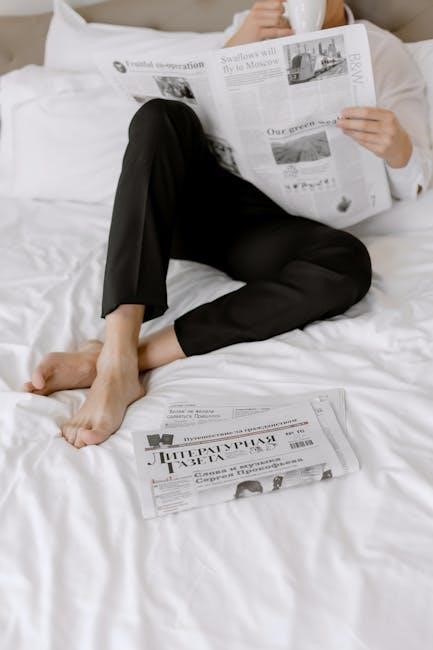Pant Break Guide: Finding the Perfect Length
A well-fitted pair of pants can significantly elevate your style, and understanding the nuances of pant break is key․ This guide will walk you through the various types of pant breaks, helping you measure and choose the perfect length․ Discover the secret to finding your ideal match․
What is Pant Break? Definition and Importance
Pant break refers to the subtle crease or fold that occurs at the bottom of your trousers where the fabric meets your shoes; It’s a crucial detail in menswear tailoring that significantly impacts the overall appearance of your outfit․ The pant break dictates how the fabric drapes and rests on your footwear, influencing the perceived length and style of your pants․
Understanding pant break is essential for achieving a polished and refined look․ The right break can enhance your body proportions, complement your personal style, and elevate your overall confidence․ Conversely, an inappropriate break can make you appear sloppy or disproportionate, undermining your sartorial efforts․
Whether you prefer a modern, minimalist aesthetic or a classic, traditional style, mastering the art of pant break is key to making a lasting impression․ By carefully considering the different types of breaks and how they interact with your body type and the occasion, you can ensure that your pants always look their best․
Types of Pant Breaks: An Overview
The world of pant breaks offers a spectrum of styles, each with its distinct characteristics and suitability for different occasions and body types․ From the clean, contemporary lines of the no break to the traditional elegance of the full break, understanding these variations is crucial for making informed sartorial choices․
Generally, there are four primary types of pant breaks to consider: no break, quarter break, half break (also known as medium break), and full break․ Each type refers to the amount of fabric that rests on the shoe, creating a subtle fold or crease․ The no break offers a minimalist look, with the hem barely touching the shoe, while the full break features a more pronounced fold, exuding a classic and formal aura․
The quarter break and half break represent intermediate options, providing a balance between modern and traditional styles․ These subtle variations allow for versatility, making them suitable for a wide range of settings and personal preferences․ Exploring these different types of pant breaks will empower you to find the perfect fit for your individual style․

The Different Types of Pant Breaks Explained
Understanding the nuances of each pant break style is essential for achieving a polished look․ We’ll now delve into the specifics of no break, quarter break, half break, and full break, exploring their characteristics and suitability for different occasions․
No Break: Modern and Trendy
The “no break” style offers a modern and fashionable look, making it a popular choice for the younger crowd․ In this style, the pant hem gracefully stops right above the shoe, creating a clean and uninterrupted line․ There are no folds or creases․
This break is ideal for slim or skinny trousers made from lightweight fabrics․ Be mindful not to go too short, or the look can appear awkward․ This style is particularly flattering for individuals with a slim or athletic build, emphasizing their well-proportioned physique․
If you’re on the shorter side, no break pants can visually elongate your legs, creating the illusion of height․ However, consider the dress code, as this style is better suited for casual environments․ Don’t forget to choose dapper dress socks to complete the look!
Quarter Break: Subtle and Versatile
The quarter break, also known as the “slight break,” offers a subtle middle ground, making it a personal favorite suit pant length․ The bottom edge of the trousers gently rests on the top of the dress shoe, creating a discreet crease at ankle level․
While not as daring as the no break style, quarter break pants are still contemporary and versatile․ This style is suitable for various occasions, including modern office settings and semi-formal events; It provides a modern and polished look without being overly trendy․
Quarter break pants are a versatile choice that can be worn by most men․ They are particularly flattering for those who prefer a refined and stylish appearance․ Its suitable for the modern businessman․ The pants are neither too short nor too long and can work well with different shoe styles․
Half Break (Medium Break): Classic and Timeless
Moving on to the classic and timeless style of half break pants, also known as medium break․ This option strikes a balance between a more conservative look and a touch of modernity․ It’s the common suit pant length;
A single crease forms around your ankle, and the hemline falls just half an inch past the shoe top, allowing just enough fabric to create a subtle fold․ This creates a polished and well-tailored silhouette, perfect for various formal and professional settings․ It’s the classic option for timeless elegance․
This style suits a wide range of body types and personal styles․ It’s especially flattering for larger men, who don’t prefer the slim or tapered look․ For those seeking a conservative yet versatile option, half break pants are the perfect choice․ This strikes a balance between modern style and traditional elegance․
Full Break: Traditional and Formal
For the traditionalists at heart, the full break is the go-to choice․ This style harkens back to the classic and traditional way of wearing trousers․ If you are one for a traditional cut, whether its trousers, chinos or dress pants the full break is your go-to․
The pant leg gathers with one generous fold around the ankle, exuding a vintage aura․ Be cautious; if you notice more than one fold, it’s a clear sign of too much break, resulting in a sloppy appearance․ This type of break creates a pronounced fold over the shoe․
Full break pants are a perfect choice for men who are taller or have a larger build․ The additional fabric and folds beautifully complement their stature, creating a harmonious balance․ For those working in conservative office environments or attending formal business events, full break pants are a safe and reliable option․

Choosing the Right Pant Break
Selecting the right pant break is crucial for a polished look․ Consider your body type, pant cut, and the occasion’s formality․ Fashion is about self-expression, so don’t be afraid to break the rules and create your own signature style․
Considering Body Type
Your body type plays a significant role in determining the most flattering pant break․ For individuals with a slim or athletic build, no-break pants can accentuate their well-proportioned physique․ Shorter men can benefit from the leg-lengthening effect of the no-break style, creating the illusion of height․
Conversely, taller men or those with a larger build may find that full-break pants provide a more balanced and harmonious silhouette․ The additional fabric and folds complement their stature․ Half-break pants offer a versatile option suitable for a wide range of body types․
Ultimately, the key is to find a pant break that enhances your natural proportions and creates a visually appealing aesthetic․ Don’t be afraid to experiment with different styles to discover what works best for you․ Consider also personal preferences and current trends․
Matching Pant Cut to Break Style
The cut of your pants significantly influences the ideal pant break․ Slim or tapered pants generally pair well with shorter breaks like no break or quarter break․ These streamlined styles complement the modern aesthetic of a minimal break, creating a clean and contemporary look․ The type of pants impacts the break in pants too․
Wider-legged styles, such as relaxed-fit or traditional trousers, can support fuller breaks without appearing baggy․ A half break or full break complements the more generous cut, adding a touch of classic elegance․ A full break works best with a baggy pair of pleated dress trousers with a wide leg opening․
Consider the overall silhouette you want to achieve when pairing pant cut and break style․ A harmonious combination enhances your body type and reflects your personal style․ Balancing the cut and break is crucial for a polished and well-proportioned appearance․
Occasion and Formality Guidelines
The occasion and level of formality play a crucial role in determining the appropriate pant break․ Formal occasions, such as business events or weddings, may call for a fuller break․ A half break or full break exudes a classic and sophisticated look, suitable for traditional settings․ Full break pants are a safe and reliable option for conservative office environments․
Casual settings often favor shorter breaks for a contemporary look․ No break or quarter break pants offer a modern and relaxed vibe, perfect for everyday wear or semi-formal events․ Quarter break pants are suitable for various occasions, including modern office settings․
Consider the dress code and atmosphere of the event when selecting your pant break․ A well-chosen break enhances your overall appearance and ensures you’re appropriately dressed for the occasion․ Remember, the goal is to strike a balance between style and appropriateness․

Measuring Pant Length for the Ideal Break
Accurate measurements are essential for achieving the perfect pant break․ Two common methods are used: outseam and inseam measurements․ Understanding how to take these measurements ensures your pants are tailored to the ideal length for your desired break․
Outseam Measurement
The outseam measurement is a widely used method for determining the overall length of your pants․ To take this measurement accurately, start at the top of the waistband and extend the measuring tape down the outer seam of the pants, all the way to the bottom of the hem․ This measurement provides the total length of the pants, from the waist to the ankle․
When measuring the outseam, ensure the pants are lying flat and that the measuring tape is straight, without any slack or pulling․ This will give you the most precise measurement․ This is a crucial step in finding the perfect pant break․
This measurement is essential for tailors when altering or creating custom-made pants․ Knowing the outseam helps ensure that the pants will fit properly and achieve the desired break, whether it’s a no break, quarter break, half break, or full break․ Accurate outseam measurement is key to a polished look․
Inseam Measurement
The inseam measurement is another critical factor in determining the correct pant length for your desired break․ To measure the inseam, begin at the crotch seam, where the front and back of the pants meet․ Extend the measuring tape down the inside of the pant leg, following the seam all the way to the bottom of the hem․
This measurement indicates the length of the pants from the crotch to the ankle, providing a direct measure of the leg length․ Accurate inseam measurement is essential because it directly influences where the pant hem will fall on your shoe, thus affecting the pant break․
Like the outseam, ensure the pants are flat and the tape is straight for the most precise reading․ The inseam is particularly useful when comparing pants sizes across different brands or when ordering online․ Knowing your inseam helps ensure a proper fit, leading to the perfect pant break that complements your style․

Pant Length While Sitting
When considering the ideal pant length, it’s essential to remember how the pants will look not only when you’re standing but also while sitting․ It’s common for suit pants to appear slightly shorter when seated, and this is a natural part of how they drape and move with your body․ The chosen pant break will influence how much the pants ride up when you sit․
Don’t be alarmed if you notice a bit more sock showing when you’re seated compared to when you’re standing․ This is because the fabric naturally adjusts as you bend your legs․ The key is to ensure that the overall suit pant length is spot-on while standing․ A well-fitted pair of pants should maintain a balanced appearance whether you’re on your feet or taking a seat․
If you’re concerned about revealing too much skin while seated, a simple solution is to opt for stylish dress socks․ These can add a touch of personality and ensure you maintain a polished look in any situation․ Ultimately, the goal is to achieve a harmonious balance between comfort and style, making sure your pants look great no matter your posture․
